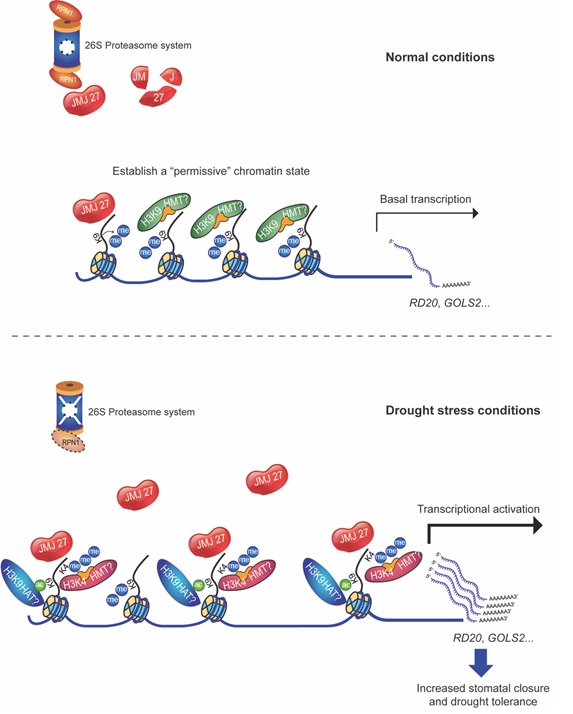The repressive mark H3K9me2 is involved in silencing transposable elements and repetitive DNA in plants. Interestingly, the repressive H3K9me2 mark is also detected at the loci of protein-coding genes, and the activation of sets of genes by drought stress is correlated with reduced H3K9me2 levels. However, the role of H3K9 methylation in the regulation of drought-stress responses remains elusive.
The research group led by Prof. JIN Jingbo from the Institute of Botany, Chinese Academy of Sciences, found that the Jumonji domain-containing protein JMJ27-mediated H3K9 demethylation positively regulates drought-stress responses at least partly through GOLS2 and RD20, two positive regulators of drought stress response.
By analyzing water loss from detached leaves of various T-DNA insertion mutants of JmjC domain-containing proteins, they identified the jmj27 loss-of-function mutants lost water more rapidly than the wild-type. Furtherly, they revealed that JMJ27 is a specific H3K9me1/2 demethylase, and regulates drought-stress responses through its H3K9 demethylase activity.
Researchers identified JMJ27-regulated genes, GOLS2 and RD20 by RNA-seq and ChIP-qPCR analyses. JMJ27 directly associated with GOLS2 and RD20, and protected these loci from silencing by reducing H3K9me2 levels under normal conditions, which enables an efficient transcriptional induction upon drought stress conditions.
Furthermore, researchers demonstrated that RPN1a, a subunit of the 26S proteasome, interacted with JMJ27 and negatively regulated JMJ27 accumulation.
They found that drought stress repressed the RPN1a-dependent degradation of JMJ27, leads to an increased association of JMJ27 at the GOLS2 and RD20 loci. The drought stress-promoted occupancy of JMJ27 at GOLS2 and RD20 chromatin may reinforce their transcriptional induction by locally reducing the H3K9me2 levels.
“This work provides a detailed molecular mechanism that explains how H3K9 landscape plasticity orchestrates plant adaptation to drought stress through the precise control of chromatin modifier abundance and occupancy at the chromatin of drought stress-responsive genes.” said the Prof. JIN.
This study entitled "JMJ27-mediated histone H3K9 demethylation positively regulates drought-stress responses in Arabidopsis" was published online in New Phytologist.
This research was supported by the National Natural Science Foundation of China and the Chinese Academy of Sciences.

Proposed model for JMJ27-mediated H3K9 demethylation in regulation of the drought-stress response in Arabidopsis thaliana (Image by IBCAS)
Article Link: https://nph.onlinelibrary.wiley.com/doi/10.1111/nph.17593
Contact:
Email: jinjb@ibcas.ac.cn
Institute of Botany, Chinese Academy of Sciences
The repressive mark H3K9me2 is involved in silencing transposable elements and repetitive DNA in plants. Interestingly, the repressive H3K9me2 mark is also detected at the loci of protein-coding genes, and the activation of sets of genes by drought stress is correlated with reduced H3K9me2 levels. However, the role of H3K9 methylation in the regulation of drought-stress responses remains elusive.
The research group led by Prof. JIN Jingbo from the Institute of Botany, Chinese Academy of Sciences, found that the Jumonji domain-containing protein JMJ27-mediated H3K9 demethylation positively regulates drought-stress responses at least partly through GOLS2 and RD20, two positive regulators of drought stress response.
By analyzing water loss from detached leaves of various T-DNA insertion mutants of JmjC domain-containing proteins, they identified the jmj27 loss-of-function mutants lost water more rapidly than the wild-type. Furtherly, they revealed that JMJ27 is a specific H3K9me1/2 demethylase, and regulates drought-stress responses through its H3K9 demethylase activity.
Researchers identified JMJ27-regulated genes, GOLS2 and RD20 by RNA-seq and ChIP-qPCR analyses. JMJ27 directly associated with GOLS2 and RD20, and protected these loci from silencing by reducing H3K9me2 levels under normal conditions, which enables an efficient transcriptional induction upon drought stress conditions.
Furthermore, researchers demonstrated that RPN1a, a subunit of the 26S proteasome, interacted with JMJ27 and negatively regulated JMJ27 accumulation.
They found that drought stress repressed the RPN1a-dependent degradation of JMJ27, leads to an increased association of JMJ27 at the GOLS2 and RD20 loci. The drought stress-promoted occupancy of JMJ27 at GOLS2 and RD20 chromatin may reinforce their transcriptional induction by locally reducing the H3K9me2 levels.
“This work provides a detailed molecular mechanism that explains how H3K9 landscape plasticity orchestrates plant adaptation to drought stress through the precise control of chromatin modifier abundance and occupancy at the chromatin of drought stress-responsive genes.” said the Prof. JIN.
This study entitled "JMJ27-mediated histone H3K9 demethylation positively regulates drought-stress responses in Arabidopsis" was published online in New Phytologist.
This research was supported by the National Natural Science Foundation of China and the Chinese Academy of Sciences.

Proposed model for JMJ27-mediated H3K9 demethylation in regulation of the drought-stress response in Arabidopsis thaliana (Image by IBCAS)
Article Link: https://nph.onlinelibrary.wiley.com/doi/10.1111/nph.17593
Contact:
Email: jinjb@ibcas.ac.cn
Institute of Botany, Chinese Academy of Sciences
